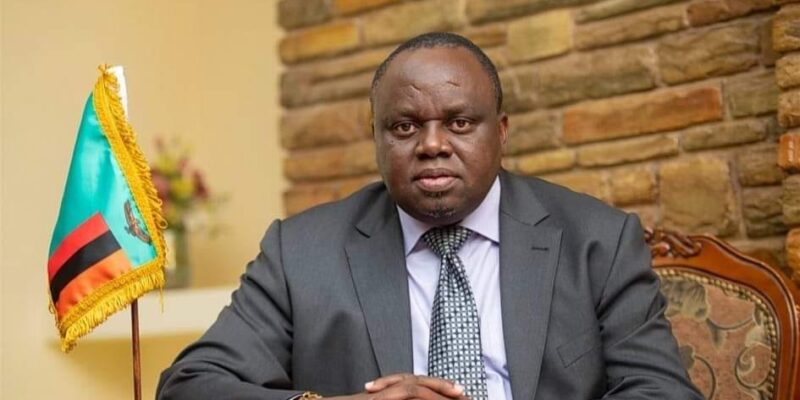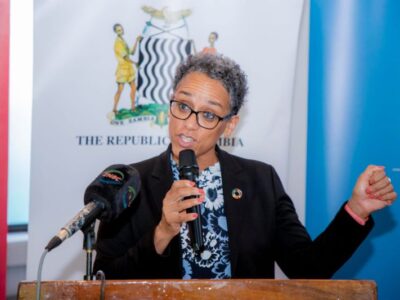There has been a hot debate regarding the transaction that ZCCM-IH and the holding company of Kansanshi Mines Plc (KMP), First Quantum Minerals (FQM) have agreed to.
In view of the fact that the transaction is yet to be approved by regulators and voted on by Shareholders of ZCCM-IH at an Extraordinary General Meeting due next January 2023, it is only fair that both sides of the arguments are presented to stakeholders so that they make informed decisions.
The government, through the Finance Minister, has put its argument in favour of the deal. I am putting across an alternative argument against the deal.
This is a professional opinion, meant to be an education piece, given the technical nature of the transaction, and not necessarily a critique of the government.
I am not privy to the details that the Parties to the transaction have agreed to.
However, on the basis of the publicly available information through the cautionary statements made by FQM in Toronto, Canada and ZCCM-IH in Lusaka on December 1, 2022, as well as the Press briefing held by the Minister of Finance and National Planning on December 6, 2022, it is possible to make an informed opinion.
And this is what this article intends to do.
ZCCM-IH’S CURRENT STATUS IN KANSASHI MINE PLC
ZCCM-IH currently holds 20% of ordinary shares in Kansanshi Mines PLC (KMP) and therefore, it is a co-owner of the company, albeit as a minority shareholder.
This status confers on it significant influence on the company.
In terms of its expected return from its investment, ZCCM- IH is entitled to two components: dividends and capital gain (through the increase in the value of its shares).
In addition, as a minority shareholder, ZCCM-IH’s rights are protected by the Companies Act. It also enjoys the right to sue the company and its directors if they not carrying out their stewardship functions properly or if they infringe upon its rights.
KMP’s growth prospects are very bright due to the expected electric car revolution and so the retention of ordinary shareholding, and thus ownership is not only persuasive but smart and prudent.
Any financial advisor giving contrary advice to their client will be looked at with askance.
The proposed transaction is going to substantially change ZCCM-IH status in KMP.
NATURE OF THE PROPOSED TRANSACTION
ZCCM –IH, in its transaction announcement regarding Kansanshi Mines Plc, stated the following:
“The Board wishes to inform the shareholders (“Shareholders”) of ZCCM Investments Holdings Plc (“ZCCM-IH” or “the Company”), and the market that, ZCCM-IH has entered into a transaction with First Quantum Minerals (“FQM”) whereby the Company will convert its dividend rights and economic value in its 20 percent equity in Kansanshi Mining Plc (”KMP”) into a life of mine royalty (the “Transaction”).
The grant of a life of mine royalty (the “Royalty”) to ZCCM-IH in respect of 3.1 percent of the gross value of Royalty products to be extracted from the KMP mine pursuant to a Royalty Agreement to be executed on the Transaction closing date.”
This announcement has two components that need to be considered, in order for one to make a proper determination as to whether it is in the best interests of the ZCCM-IH and Zambia as a whole, given that the company belongs to the 20 million Zambians.
The first relates to the change in the income stream for ZCCM-IH from dividends to royalty.
And the second relates to the ownership of the company as it relates to the 20% Ordinary shares that ZCCM- IH currently holds.
During the recently held press conference in defense of the deal, the Government through the Finance Minister, Dr. Situmbeko Musokotwane was selling the transaction to the public as a mere change of the revenue model, from the dividend model to the Royalty model.
“The transaction that was announced, aims at converting the current ZCCM-IH dividend rights in Kansanshi Mining Plc into royalty rights.
Unlike the dividend revenue model, the royalty revenue is more predictable, guaranteed and consistent.
The right to receive quarterly Royalty payments will ensure that ZCCM-IH is guaranteed a predictable and regular revenue stream over the life of the mine of Kansanshi Mining.
“When we assess the dividend model performance from 2009-2021, ZCCM-IH received a total of US $337 million. You may wish to note that no amount was received in form of dividends in 2016 and 2017 as no dividend was declared.
However, if the royalty model was in place during the same period, ZCCM-IH could have received a total of US $671 million.
Our future projections indicate that just over a 9-year period, royalty receipts will amount to US $625 million which is significantly higher than the amounts received in the last 14 years,” Dr. Musokotwane argued.
The above pitch is very attractive, persuasive, and a no-brainer to a layperson. However, the Finance Minister’s justification of the royalty model as per the above statement has been criticized by many experts, because it was not giving a full picture of the transaction.
It was rather cheery picking the benefits of the transaction, and leaving out the immense disadvantages of the transaction in the long term.
“Dividends are not the only reason that drives prudent investors. Asset growth is even more paramount.
And most importantly, if the revenue model is as lucrative as the Minister puts it, why is FQM as a major shareholder not adopting the same model? But instead wants to become a
100% beneficiary of Dividends that is supposedly not as lucrative,” Bruce Mumba wrote in his analysis of the transaction in the online publication Zambian Eye on December 7, 2022.
It should also be noted that the figures that are being quoted by the Finance minister, and in those of ZCCM-IH cautionary statement, can easily be contested as exaggerated if one was to dig deeper and analyse the financial statements of the entities involved.
“ZCCM IH claims KMP will make a dividend declaration of US$ 975 million to which they will receive US$ 195 million in proportion to the shareholding of 20%. This is brilliant but sounds too good to be true.
As I earlier indicated, my review of the FQM consolidated financial statements shows that in 2021, Kansanshi Mining Plc posted a gross profit of US$ 969 million and US$ 464 million in 2020.
Now, this profit is before KMP covers all its operating costs, loan interest charges and taxes, dividends are by law and corporate practice declared and paid out of the profits generated by the company, which by my rough estimate stands at around US$822 million.
This leaves only US$ 147 million for distribution as dividends and that is if the Board resolves to pay all profits generated as dividends.
Highly unlikely,” Charles Mwewa, a financial analyst wrote in his article on the deal in Lusaka Times.
Furthermore, the deal itself cannot be fully relied on to materialize in the same positive way that it is being projected.
There are potential risks. FQM itself has issued a disclaimer or caveat on the transaction in its statement in Toronto, Canada on the transaction of Kansanshi Mines Plc.
“Certain statements and information herein, including all statements that are not historical facts, contain forward-looking statements and forward-looking information within the meaning of applicable securities laws.
Forward-looking statements and information by their nature are based on assumptions and involve known and unknown risks, uncertainties and other factors which may cause the actual results, performance, or achievements to be materially different from any future results, performance, or achievements expressed or implied by such forward-looking statements or information.
The Company undertakes no obligation to reissue or update forward-looking statements or information as a result of new information or events after the date hereof except as may be required by law,” Statement issued by FQM on 1st December 2022 states.
The second component of the transaction, which is even more important to the Zambian people, is the fate of the 20% of ordinary shares that ZCCM-IH has in KMP.
This has been greatly underplayed for some unknown reason. I will attempt to unpack and unravel this, based on the publicly available information.
It is vitally important to first appreciate that the objective of Zambia’s acquisition of minority interests in mining houses like 20% ordinary shares in KMP was STRATEGIC.
It is, therefore, rather simplistic to reduce the debate of the current transaction to just being a FINANCIAL one.
There are many intangibles that are involved that need to be considered. The ZCCM-IH is not a private company, but rather a public company, owned by Zambians whose interests are beyond dividends or royalties.
In order to fully understand the fate of the 20%, there is a need to refer to the statements on the transaction issued by both ZCCM-IH in a cautionary statement in Lusaka to its shareholders, and First Quantum Mines (FQM)’s news release in Toronto Canada on 1st December 2022.
“At closing ZCCM-IH will de-recognize its equity stake in KMP as an investment in an associate and recognize the acquired Royalty as a financial asset.
“The forward-looking statements in this news release include statements as to the anticipated conversion of ZCCM-IH’s ordinary shares into preference shares.
“The varied rights attached to the ZCCM-IH Class A shares in KMP will be amended and prescribed in the amended KMP Articles of Association (“New KMP Articles”) to be adopted at Closing.
“Post transaction, the economic value of ZCCM-IH’s 20% equity stake in KMP will be realised through the VAT refunds.
“Pursuant to the New KMP Articles and the Termination Agreement between KHL, KMP and ZCCM-IH relating to the termination of rights and obligations under the KMP Shareholders Agreement,” the ZCCM-IH and FQM statements have clearly spelled out the nature of the transaction.
Although the above statements are couched in some financial engineering language and legal jargon, the net effect of all the above is that, as part of the process of this transaction, ZCCM-IH is most likely to lose ownership of 20% Ordinary Shares in KMP by way of conversion of the same into preference shares are almost equivalent to being a creditor of the company.
The likely result will be FQM becoming a 100% owner of Kansanshi Mines PLC. ZCCM- IH will cease to be a partial owner of the Kansanshi Mine.
This transaction is simply PRIVATIZATION in disguise. The term privatisation has been avoided because of being toxic in the Zambian environment.
This should not come as a surprise because in February 2019, Mining Technology and LusakaTimes, quoted Bloomberg as having reported that FQM had offered the Zambian government to acquire the remaining 20% stake in Kansanshi Mine Plc for as much as $700 Million.
The assured winner in this deal will be First Quantum Minerals. There are numerous benefits to accrue to FQM. But the obvious one is the freedom for them to make any decision and take any action without any encumbrances.
The suit by ZCCM-IH of FQM in the Lusaka High Court on October 28, 2016, must be fresh in the minds of owners and directors of the FQM group. In the said suit, ZCCM-IH was claiming up to $ 1.4 billion from FQM Ltd, accusing it of fraud.
They alleged that on several occasions, FQM fraudulently engaged in transactions totaling
in excess of $2 billion for the benefit of the FQM Group, which was detrimental to ZCCM-IH’s interests and those of the nation.
The ZCCM-claims included $228 million in interest on $2.3 billion of loans that ZCCM-IH claimed FQM wrongly borrowed from the Kansanshi Copper mine and used the money as cheap finance for other operations as well as 20 percent of the principal amount, or $570 million.
WHY ROYALTY TRANSACTION DEAL IS BAD FOR ZAMBIA
There is a general feeling by the public that the proposed deal is not in Zambia’s best interests. The first important point why the deal is bad for Zambia is purely from the prudent investment point of view. It is a known fact that KMP’s future growth prospects are bright given the electric car revolution and the growth in the green economy.
The expectation is that both dividend payments and the value of shares will exponentially increase. And it was flawed decision-making for ZCCM-IH to use past records as the basis of the divestment/ swapping of ordinary shares with preference shares. ZCCM-IH stands to lose out on the expected success.
The past 30 years of experience by Zambians have concluded that the wholesome privatisation of mines has not benefited them, but only foreigners and a few individual Zambians.
There has been, therefore, an outcry and clamour for increasing the country’s shareholding interests to significant levels in mining houses without necessarily having controlling interests.
The current deal is going in the opposite direction and against public opinion.
The second downside of the proposed transaction is that the deal will give FQM 100% ownership of KMP and a carte blanche to make decisions that are not necessarily in the best interests of the country.
The level of animosity against the transaction is reflected in the number of News diggers Opinions issued this month-December, 2022 on the transaction.
There are also Zambians who have written negatively about it.
The outcry must have forced the Minister of Finance to hold a very unconvincing press conference to justify the deal. The newspaper has been at the forefront of criticising the deal.
“As we have said in our earlier editorial comments, this trouble that the UPND government has plunged itself into a result of failure to consult.
The shares that ZCCM-IH holds in the mining companies are held in trust for the people of Zambia.
The President and those around him need to distinguish between personal property and government assets. When dealing with state assets, you ask the people first before acting,” the News Diggers Newspaper advised in one of its several editorial opinions on the transaction.
“Surely in whose best interest in this deal? Why can’t the other owners of the same mine also go into such type of arrangement with the government to say ‘for our 80 percent shareholding we are going to be getting this much. Why should they push it on us? I think this should have been taken to Parliament for debate.
A lot of economic jargon is being used to confuse the population and posterity will judge us harshly. The generation of Dr. Kenneth Kaunda is turning in their graves because we have been unable to harness anything from the Mining Industry,” Dr. Lubinda Haabazoka, an economist, lamented in an interview with the Mast Newspaper on the transaction.
There is also a body of opinion in Zambia that feels that in order for us to reduce the risk of being cheated by Mining houses, the country should be diversifying its income streams and not reducing them.
The argument is that we should be ensuring that we gain income from taxes, dividends, and royalties by the government as custodians of minerals as well as capital gains from the capital growth of shares.
This transaction is going against all this. We should also be at the decision-making table. This is what smart countries like China, Botswana and Tanzanian have done.
Read more: Zambia Monitor | Latest Zambian News
CONCLUSION
There are a lot of intangible and indirect benefits that flow from the government or its agencies in having part ownership of shares in Multinational Enterprises (MNEs).
The deterrent effects on opaque deals are a very compelling argument. And in order to make a proper decision, the government should consider further analysis of the deal so that the implications of the transaction on the following: loss of value in capital gains on ordinary shares, taxation and possible loss of tax revenue to the government, illicit financial flows, transfer pricing risks, foreign exchange, corporate governance, national security and other intangibles are taken into account.
A helicopter view of the transaction is required, rather than the current silo approach of just looking at revenue models.
This transaction has far-reaching implications for Zambia. It should be noted that once the deal is signed, it is irreversible. We should learn from the harm that the development agreements we signed some decades have done to our economy.
The best way forward is for the deal to be shelved for further debate and consultations. There is no need to rush the deal because it is not a matter of life and death.
FQM and the mining houses have already been given so many incentives already by the government.









Comments